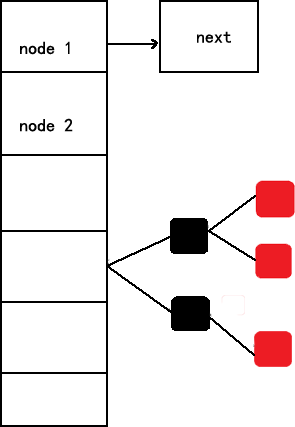0. HashMap的数据结构
0.1 成员变量
//HashMap的主干数组,可以看到就是一个Node数组,初始值为空数组{}
transient Node[] table;
//操作map的一个接口
transient Set> entrySet;
//实际存储的key-value键值对的个数
transient int size;
//用于快速失败,由于HashMap非线程安全,在对HashMap进行迭代时,如果期间其他线程的参与导致HashMap的
结构发生变化了(比如put,remove等操作),需要抛出异常ConcurrentModificationException
transient int modCount;
//阈值,当table == {}时,该值为初始容量(初始容量默认为16);当table被填充了,也就是为table分配内存空间
后,threshold一般为 capacity*loadFactory。HashMap在进行扩容时需要参考threshold,后面会详细谈到
int threshold;
// 负载因子,代表了table的填充度有多少,默认是0.75
final float loadFactor;
0.2 数据结构图
java8最新引入红黑树,当链表的长度大于8的时候,把链表转化成红黑树。让查找等操作的性能提高,时间复杂度为到O(logn),而不是链表中的O(n),结构如下图所示:
1. HashMap的重要方法
1.1 put方法
put内部其实是调用putVal方法,所以下面分析putVal方法,主要步骤写在代码注释中
final V putVal(int hash, K key, V value, boolean onlyIfAbsent,
boolean evict) {
Node[] tab; Node p; int n, i;
// 1. tab为空则创建
if ((tab = table) == null || (n = tab.length) == 0)
n = (tab = resize()).length;
// 2. 计算index,并对null做处理
if ((p = tab[i = (n - 1) & hash]) == null)
tab[i] = newNode(hash, key, value, null);
else {
Node e; K k;
// 3. 节点key存在,直接覆盖value
if (p.hash == hash &&
((k = p.key) == key || (key != null && key.equals(k))))
e = p;
// 4. 判断该链为红黑树
else if (p instanceof TreeNode)
e = ((TreeNode)p).putTreeVal(this, tab, hash, key, value);
// 5. 该链为链表
else {
for (int binCount = 0; ; ++binCount) {
if ((e = p.next) == null) {
p.next = newNode(hash, key,value,null);
//链表长度大于8转换为红黑树进行处理
if (binCount >= TREEIFY_THRESHOLD - 1) // -1 for 1st
treeifyBin(tab, hash);
break;
}
// key已经存在直接覆盖value
if (e.hash == hash &&
((k = e.key) == key || (key != null && key.equals(k))))
break;
p = e;
}
}
if (e != null) { // existing mapping for key
V oldValue = e.value;
if (!onlyIfAbsent || oldValue == null)
e.value = value;
afterNodeAccess(e);
return oldValue;
}
}
++modCount;
// 6. 超过最大容量 就扩容
if (++size > threshold)
resize();
afterNodeInsertion(evict);
return null;
}
1.2 resize方法
put方法中的扩容方法,table是数组的结构,如果插入的元素无法装载更多的元素的时候就需要扩容了。所谓扩容,就是新申请一个较大容量的数组table,然后将原来的table中的内容都重新计算哈希落到新的数组table中来,然后将老的table释放掉。这里面有两个关键点,一个是新哈希数组的申请以及老哈希数组的释放,另外一个是重新计算记录的哈希值以将其插入到新的table中去。首先第一个问题是,扩容会扩大到多少,通过观察上面的代码可以确定,每次扩容都会扩大table的容量为原来的两倍,当然有一个最大值,如果HashMap的容量已经达到最大值了,那么就不会再进行扩容操作了。第二个问题是HashMap是如何在扩容之后将记录从老的table迁移到新的table中来的。上文中已经提到,table的长度确保是2的n次方,那么有意思的是,每次扩容容量变为原来的两倍,那么一个记录在新table中的位置要么就和原来一样,要么就需要迁移到(oldCap + index)的位置上。
final Node[] resize() {
//引用扩容前的Node数组
Node[] oldTab = table;
int oldCap = (oldTab == null) ? 0 : oldTab.length;
int oldThr = threshold;
int newCap, newThr = 0;
if (oldCap > 0) {
// 最大数组限制
if (oldCap >= MAXIMUM_CAPACITY) {
threshold = Integer.MAX_VALUE;
return oldTab;
}
// 没超过最大值,就扩充为原来的2倍
else if ((newCap = oldCap << 1) < MAXIMUM_CAPACITY &&
oldCap >= DEFAULT_INITIAL_CAPACITY)
newThr = oldThr << 1; // double threshold
}
else if (oldThr > 0) // initial capacity was placed in threshold
newCap = oldThr;
else { // zero initial threshold signifies using defaults
newCap = DEFAULT_INITIAL_CAPACITY;
newThr = (int)(DEFAULT_LOAD_FACTOR * DEFAULT_INITIAL_CAPACITY);
}
if (newThr == 0) {
float ft = (float)newCap * loadFactor;
newThr = (newCap < MAXIMUM_CAPACITY && ft < (float)MAXIMUM_CAPACITY ?
(int)ft : Integer.MAX_VALUE);
}
threshold = newThr;
@SuppressWarnings({"rawtypes","unchecked"})
Node[] newTab = (Node[])new Node[newCap];
table = newTab;
if (oldTab != null) {
// 把每个bucket都移动到新的buckets中
for (int j = 0; j < oldCap; ++j) {
Node e;
if ((e = oldTab[j]) != null) {
oldTab[j] = null;
if (e.next == null)
newTab[e.hash & (newCap - 1)] = e;
else if (e instanceof TreeNode)
((TreeNode)e).split(this, newTab, j, oldCap);
else { // preserve order
Node loHead = null, loTail = null;
Node hiHead = null, hiTail = null;
Node next;
do {
next = e.next;
if ((e.hash & oldCap) == 0) {
if (loTail == null)
loHead = e;
else
loTail.next = e;
loTail = e;
}
else {
if (hiTail == null)
hiHead = e;
else
hiTail.next = e;
hiTail = e;
}
} while ((e = next) != null);
if (loTail != null) {
loTail.next = null;
newTab[j] = loHead;
}
if (hiTail != null) {
hiTail.next = null;
newTab[j + oldCap] = hiHead;
}
}
}
}
}
return newTab;
}
1.3 get方法
根据key的hashCode来定位到table中的index,如果该位置为null,说明没有没有记录落到该位置上,也就不存在我们查找的记录,直接返回null。如果该位置不为null,说明至少有一个记录落到该位置上来,那么就判断该位置的第一个记录是否使我们查找的记录,如果是则直接返回,否则,根据该index上是一条链表还是一棵红黑树来分别查找我们需要的记录,找到则返回记录,否则返回null。下面来看一下如何判断HashMap中是否有一个记录的方法。
public V get(Object key) {
Node e;
return (e = getNode(hash(key), key)) == null ? null : e.value;
}
final Node getNode(int hash, Object key) {
Node[] tab; Node first, e; int n; K k;
if ((tab = table) != null && (n = tab.length) > 0 &&
(first = tab[(n - 1) & hash]) != null) {
if (first.hash == hash && // always check first node
((k = first.key) == key || (key != null && key.equals(k))))
return first;
if ((e = first.next) != null) {
if (first instanceof TreeNode)
return ((TreeNode)first).getTreeNode(hash, key);
do {
if (e.hash == hash &&
((k = e.key) == key || (key != null && key.equals(k))))
return e;
} while ((e = e.next) != null);
}
}
return null;
}
3. 其他的原理
3.1 hash实现
static final int hash(Object key) {
int h;
return (key == null) ? 0 : (h = key.hashCode()) ^ (h >>> 16);
}
看代码,没有直接使用key的hashcode(),而是使key的hashcode()高16位不变,低16位与高16位异或作为最终hash值。官方解释为:如果直接使用key的hashcode()作为hash很容易发生碰撞。比如,在n - 1为15(0x1111)时,散列值真正生效的只是低4位。当新增的键的hashcode()是2,18,34这样恰好以16的倍数为差的等差数列,就产生了大量碰撞。因此,设计者综合考虑了速度、作用、质量,把高16bit和低16bit进行了异或。因为现在大多数的hashCode的分布已经很不错了,就算是发生了较多碰撞也用O(logn)的红黑树去优化了。仅仅异或一下,既减少了系统的开销,也不会造成因为高位没有参与下标的计算(table长度比较小时),从而引起的碰撞。
